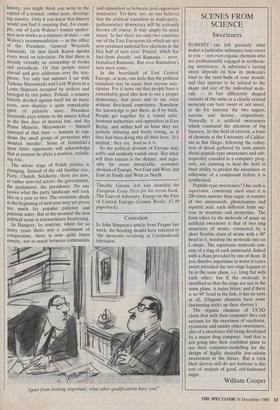SCENES FROM SCIENCE
Sweeteners
NOBODY can tell precisely what makes a particular substance taste sweet to you — not even organic chemists who are professionally engaged in synthesis- ing sweeteners. A substance's tasting sweet depends on how its molecules bind to the taste-buds of your mouth; and that appears to be related to the shape and size of the individual mole- cule — in fact differently shaped variants of the same or a closely related molecule can taste sweet or not sweet, as do for instance the two sugars, sucrose and lactose, respectively. Naturally it is artificial sweeteners which command the attention of big business. In this field of interest, a team of chemists at the University of Califor- nia in San Diego, following the collec- tion of detail gathered by taste panels about peptide-type sweeteners and sub- sequently encoded in a computer prog- ram, are claiming to lead the field in their ability to predict the sweetness or otherwise of a compound before it is synthesised.
Peptide-type sweeteners? One such is aspartame, commonly used since it is 200 times sweeter than sugar: it consists of two aminoacids, phenylamine and aspartic acid, each different from suc- rose in structure and properties. The form taken by the molecule of many an artificial sweetener is that of two ring structures of atoms; connected by a short flexible chain of atoms with a 90° bend in it, bending the molecule into an L-shape. The aspartame molecule con- sists of a ring of each aminoacid, linked with a chain provided by one of them. If you dissolve aspartame in water it tastes sweet provided the two rings happen to be in the same plane, i.e. lying flat with each other; but if the molecule is modified so that the rings are not in the same plane, it tastes bitter; and if there is no 90° bend in the link, it has no taste at all. (Organic chemists have some fascinating tricks up their sleeves.)
The organic chemists of UCSD claim that with their computer they can account for the sweetness of saccharin, cyclamate and sundry other sweeteners; also of a sweetener still being developed by a major drug company. And that is not going into their confident plans to use their computer-modelling for the design of highly desirable low-calorie sweeteners in the future. But a trick their sleeves still do not harbour is this sort of analysis of good, old-fashioned sugar.
William Cooper


















































 Previous page
Previous page